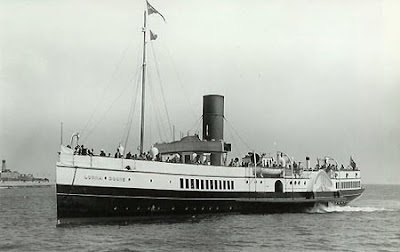Both use exactly the same patterns and construction but have differing stitch counts. The sample piece is knitted using Jamieson & Smith 2 ply Lace in shade L1. The sample took two 25g balls which have approximately 169m on each ball.
I began with a centre construction working loops at each end to be picked up to knit 4 separate border panels.
Once each border panel was completed I then worked the lace edging for each piece.
With all four borders knitted and the lace edging worked right around, the border pieces can then be joined together. I wanted to experiment a little here and instead of working a regular herringbone join I created a more open, abstract version which would hopefully look quite random and cobwebby.
What I particularly love about this type of join is that its very difficult to see where the knitting ends and the sewing begins which then leaves the observer questioning how it has been achieved. Blocked it is about 60 cm square.
This lace panel is destined to hang on a wall in our house next to a vintage embroidery that I recently rescued and framed. I hope to stitch the panel to a background which I will then mount inside a frame before hanging.
So on to my humungous shawl. I was very lucky to be gifted two skeins of Lorna Doone from Natural Dye Studio.
The yarn is a blend of 40% Exmoor Horn, 30% Zwartbles and 30% Wensleydale. Exmoor Horn is also where my very own Excelana begins so I was very excited to try a different blend based on it. It is a 4 ply/sport weight yarn available in 100g skeins with 335m on each skein. The very dark brown tones of the Zwartbles fleece is combined with the lighter natural tones of the Exmoor and Wensleydale to create the overall effect of a grey yarn. And it has also been spun by John Arbon at his mill in Devon just like Excelana. The yarn is a joy with which to knit. It has incredible stretch and surprisingly good stitch definition for so flecked a yarn. It is soft, light and warm making it the perfect choice for this type of shawl. I can't wait to get it finished and be able to wear it.
The shawl in its entirety uses 4 skeins of Lorna Doone, so around 1400m of 4 ply weight yarn and is knitted throughout on a 4mm needle and it will be around 1.5 metres square once blocked. I particularly love how the pattern looks so different using such contrasting yarns.
There is another less yarny reason why I so wanted to try out this yarn though. And it is its name. Named after the main character Lorna Doone in the book of the same name by R D Blackmore, it shares its first name with my mum, who was also named after Lorna Doone.
In actual fact, my mum was named after a Red Funnel paddle steamer which first sailed in 1896 and was in turn named after the then very recently published book. My great grandfather, Reuben Jones from Aberdovey in Wales, was born in 1897 and by the time he was 14 years of age he had joined the Royal Navy.
 |
| My great grandfather, Reuben Jones |
 |
| The Lorna Doone in its civilian role as a pleasure steamer |
 |
| Reuben, centre front, on board a PSN vessel, not long before he passed away |
 |
| Lilian Margerite Jones - or 'Ninnie Barc' as she became known in later years |
There is so much more of this story to be researched and told and a pattern to create around it but at least for now a little part of Reuben and Lilian's story is known and the connection between them, Lorna Doone and a shetland lace shawl has been made.
for now,
Ruby xx








2 comments :
Oh, I loved this post! Gorgeous knitting and family history all in one! Thank you for sharing :)
Fantastisk!!! Thank you.
Post a Comment